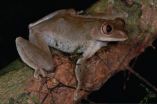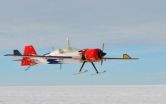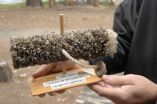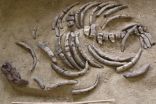(Press-News.org) KANSAS CITY, MO - In textbooks, the grand-finale of cell division is the tug-of-war fought inside dividing cells as duplicated pairs of chromosomes get dragged in opposite directions into daughter cells. This process, called mitosis, is visually stunning to observe under a microscope. Equally stunning to cell biologists are the preparatory steps cells take to ensure that the process occurs safely.
Molecular biologists define those "cell cycle" steps as: G1, when cells survey chromosomes for damage and, if they pass muster, prepare to replicate them; S phase, in which replication occurs; and G2, when cells check duplicated chromosomes one last time for damage and construct the protein machinery required for mitosis.
Failure of a single step is ominous: almost any disease--from autoimmunity to neurodegeneration--is marked, if not caused, by some kind of cycle malfunction. The most obvious is cancer, in which G1 or G2 quality control steps fail and uncontrolled division of tumor cells harboring oncogenic mutations can go totally unchecked.
Halting abnormal cell division thus requires knowing what genes are operational in G1 versus G2. To define them, Stowers Institute of Medical Research Associate Investigator Matt Gibson, Ph.D., undertook a genome-wide comparison of genes expressed during the G1 and G2 phases in larval tissue of the fruitfly Drosophila melanogaster. This work, currently reported online and in the April 14, 2014 print issue of Developmental Cell, catalogues over 300 genes differentially expressed at these steps. Significantly, it is the first to accomplish that in a multicellular organism.
Researchers have previously performed genome-wide screens for cell cycle genes in yeast or cultured animal cells where it is possible to obtain large numbers of cells at precise phases of cell cycle progression. "We started out from the general principle that regulation of the cell cycle in a complex tissue could be very different from how cells divide in a dish," says Gibson. "To understand what happens physiologically, we wanted to apply genome-scale methods to characterize cell division as it occurs in the animal."
Liang Liang, Ph.D., a Gibson lab graduate student, led the all-Stowers team, assisted by Jeff Haug, head of the Cytometry Core, and Genomic Scientist Chris Seidel, Ph.D. Liang began by painstakingly optimizing procedures to dissociate wing disc tissue but keep it viable long enough to analyze. Haug, who worked with her in this phase of the project, calls this a feat in itself, requiring what he calls "institutional memory" of methods used by other Stowers investigators to prepare cells from Drosophila tissues.
The team then stained living target cells with dye that labels DNA. That procedure allowed them to sort cells into two bins using a technique called flow cytometry: one bin contained cells with one copy of the genome (cells in G1) and the other contained cells with two genomes (those in G2, which had replicated their DNA but not yet divided).
Microarray analysis then identified every gene exhibiting different levels of expression in the G1 or G2 cell populations. Some were expressed in both, but 431 genes were upregulated in G1 and 336 during G2. The team further validated candidates by genetically "knocking down" each separately in wing discs and examining adult fly wings for defects, which they saw in 80% of cases.
Gibson says that many usual suspects were activated at the "right" time. "Things that control DNA replication were enriched in G1, while factors regulating mitosis were expressed in G2," he explains. The surprise came when the team compared data with parallel profiles obtained using cultured Drosophila S2 cells: many of the roughly 200 genes differentially expressed in G1 or G2 in disc cells were uniformly expressed in S2 cells. Likewise, close to 100 genes differentially expressed in S2 cells showed uniform expression in disc cells.
"What was exciting was the plasticity we saw in cell cycle regulation of gene expression," says Liang, noting different profiles seen in disc versus S2 cells. "Every animal uses the same cell cycle machinery, but that machinery may be regulated very differently depending on the cell type, even in the same organism."
First and foremost, the work provides a searchable resource freely available to scientists and citizens alike at the Stowers Original Data Repository. There, you can see if your favorite gene is expressed in G1 or G2 in wing discs or S2 cells and view pictures of what fly wings look like when that gene is deficient.
The work also identifies brand-new suspects for the Gibson lab. Wing disc cells and cells that line almost every mammalian body cavity are epithelial cells, which grow in sheets. They divide in a peculiar fashion: right before mitosis the nucleus of an elongated epithelial cell moves into one end of the cell for cell division, a process called interkinetic nuclear movement (IKNM). Gibson is interested in the mechanics of IKNM, in part because epithelial cell cancers, termed carcinomas, comprise over 80% of all malignancies. "One motivation for this study was to discover what links IKNM to the cell cycle," he says. "That required a global view."
He was right. The paper reports two genes that when knocked down in wing discs disrupt IKNM as cells divide without interrupting division itself. Intriguingly, one is a long noncoding RNA (lncRNA), a currently mysterious class of RNAs that does not encode proteins but instead may regulate downstream gene expression.
Seidel, who helped analyze data for the paper, says next-gen technologies free researchers to ask unbiased questions, without which the team would have surely missed the lncRNA. He compares "old" versus "new" genome exploration to mapping the earth before and after satellites. "Before, you sailed from place to place for hundreds of years establishing landmarks to create a map," he says. "Afterwards, a few hours' worth of data collection offered a comprehensive, global view."
Gibson concurs, but with a nod to the field's Magellans and Ponce de Leons. "Historically, scientists studied cell cycle control by taking a gene-by-gene and protein-by-protein approach, usually in cultured cells," he says. "Those pioneers provided immense insight into how cell division works. Now we have tools to determine how that fundamental process is fine-tuned to operate in the complex and varied contexts present in a multicellular animal."
INFORMATION:
The Stowers Institute for Medical Research and the Burroughs Wellcome Fund for Medical Research funded the study.
About the Stowers Institute for Medical Research
The Stowers Institute for Medical Research is a non-profit, basic biomedical research organization dedicated to improving human health by studying the fundamental processes of life. Jim Stowers, founder of American Century Investments, and his wife, Virginia, opened the Institute in 2000. Since then, the Institute has spent over 900 million dollars in pursuit of its mission.
Currently, the Institute is home to nearly 550 researchers and support personnel; over 20 independent research programs; and more than a dozen technology-development and core facilities.
Going global
Stowers team reports genome-wide analysis of genes that drive cell division in a multicellular organism
2014-04-02
ELSE PRESS RELEASES FROM THIS DATE:
New model shows moderate resource use & reduced economic inequality keys to sustainability
2014-04-02
COLLEGE PARK, MD - A new analytical tool adds human factors to a widely-used biological model of how animal populations interact, suggesting that human societies can reach a steady state that is sustainable when they do not over-deplete natural resources and avoid extreme economic inequality.
The paper, titled "Human and nature dynamics (HANDY): modeling inequality and use of resources in the collapse or sustainability of societies," was published in the May 2014 issue of the journal Ecological Economics. Its authors are Safa Motesharrei, a Ph.D. candidate in applied ...
One or 2? How to decide how many species you have got
2014-04-02
It is often difficult to decide whether two animals belong to the same or two distinct species. This can be especially challenging for animals which externally look very similar. In a recent study, published in the open access journal Zoosystematics and Evolution, scientists from the Museum für Naturkunde Berlin use genetic data and sound analysis to test if treefrogs from West and Central Africa belong to different or the same species.
Due to the fact that, when external characters are used, only size is useful to distinguish these frogs the scientists employed additional ...
Remotely operated aircraft successfully tested as tool for measuring changes in polar ice sheets
2014-04-02
Scientists studying the behavior of the world's ice sheets--and the future implications of ice sheet behavior for global sea-level rise--may soon have a new airborne tool that will allow radar measurements that previously would have been prohibitively expensive or difficult to carry out with manned aircraft.
In a paper published in the March/ April edition of IEEE Geoscience and Remote Sensing Magazine, researchers at the Center for Remote Sensing of Ice Sheets (CReSIS) at the University of Kansas noted that they have successfully tested the use of a compact radar system ...
Don't move a mussel (or a clam, or a snail)
2014-04-02
(Millbrook, NY) Anyone that has spent time at a seaside pier has witnessed the destruction barnacles wreak on boat hulls. But biofouling animals are not limited to marine environments. A new paper published in the journal Frontiers in Ecology and the Environment estimates that the global management of freshwater mussels, clams, and other clinging animals costs $277 million U.S. dollars annually.
Biofoulers are organisms that accumulate underwater on hard surfaces, to the detriment of property and economically important activities, such as shipping, power generation, ...
Beyond proficiency: How early English exposure influences non-native speakers
2014-04-02
PRINCETON, N.J.—Non-native speakers exposed to English before moving to America are more likely to use the language in their daily lives in the United States, according to a report led by Princeton University's Woodrow Wilson School of Public and International Affairs.
Such early exposure – through newspapers, books, TV and classes as well as traveling – may help determine an immigrant's socioeconomic mobility, as English proficiency is strongly tied to cultural and social assimilation. The report, featured in the journal Social Science Research, is one of the first ...
Americans using more energy according to Lawrence Livermore analysis
2014-04-02
Americans used more renewable, fossil and even nuclear energy in 2013, according to the most recent energy flow charts released by Lawrence Livermore National Laboratory.
Each year, the Laboratory releases energy flow charts that illustrate the nation's consumption and use of energy. Overall, Americans used 2.3 quadrillion thermal units more in 2013 than the previous year.
The Laboratory also has released a companion chart illustrating the nation's energy-related carbon dioxide emissions. Americans' carbon dioxide emissions increased to 5,390 million metric tons, ...
Killing a name of an extinct sea cow species
2014-04-02
Sirenians, or sea cows, are a particular group of mammals that superficially resembles whales in having, amongst other features, a streamlined-body and horizontal tail fluke. Though belonging to the so-called marine mammals, such as whales and seals, sea cows are members of a group having a single origin that includes their closest living relatives, the proboscideans (or elephants in the broader sense).
Today, sirenians are known by only four species, but their fossil record is much more diverse documenting the transition from land-dwelling animals to fully aquatic ones. ...
Ethics guidelines for next generation of risky NASA missions
2014-04-02
MEDIA ADVISORY: Institute of Medicine Committee to Report on Ethical Guidelines For Health Standards on Next Generation of NASA Missions: Long Duration and Exploration Spaceflights
WHEN: Embargoed until Wednesday April 2, 2014 11:00 AM EDT
WHAT: Spaceflights beyond low earth orbit or lasting longer than 30 days, including extended stays on the International Space Station and missions to Mars, will likely expose astronauts to increased and even unknown levels of risk, and therefore would not meet NASA's current health standards. The space agency commissioned a report ...
Intelligent warning systems may make 'dilemma zone' safer
2014-04-02
Most drivers have experienced a traffic signal that turns yellow just as they approach an intersection, which makes it difficult for them to decide whether to stop or proceed through it. The wrong choice in this critical situation, known as the "dilemma zone," may lead to crashes, especially at high-speed intersections. A new study published in Human Factors examines how intelligent warning systems help drivers negotiate the dilemma zone and encourage safer driving behavior.
"Intelligent systems could improve driver safety by potentially reducing crashes at signalized ...
Longer stay in hospital ICU has lasting impact on quality of life
2014-04-02
Patients have substantial physical impairments even two years after being discharged from the hospital after a stay in an intensive care unit (ICU), new Johns Hopkins research suggests.
The scientists found that for every day of bed rest in the ICU, muscle strength was between 3 and 11 percent lower over the following months and years.
"Even a single day of bed rest in the ICU has a lasting impact on weakness, which impacts patients' physical functioning and quality of life," says Dale M. Needham, M.D., Ph.D., an associate professor of medicine and of physical medicine ...
LAST 30 PRESS RELEASES:
This new understanding of T cell receptors may improve cancer immunotherapies
A new fossil face sheds light on early migrations of ancient human ancestor
A new immunotherapy approach could work for many types of cancer
A new way to diagnose deadly lung infections and save lives
40 percent of MRI signals do not correspond to actual brain activity
How brain-inspired algorithms could drive down AI energy costs
Gum disease may be linked to plaque buildup in arteries, higher risk of major CVD events
Contrails are a major driver of aviation’s climate impact
Structure of dopamine-releasing neurons relates to the type of circuits they form for smell-processing
Reducing social isolation protects the brain in later life
Keeping the heart healthy increases longevity even after cancer
Young adults commonly mix cannabis with nicotine and tobacco
Comprehensive review illuminates tau protein's dual nature in brain health, disease, and emerging psychiatric connections
Book prepares K-12 leaders for the next public health crisis
Storms in the Southern Ocean mitigates global warming
Seals on the move: Research reveals key data for offshore development and international ecology
Sports injuries sustained during your period might be more severe
World's first successful 2 Tbit/s free-space optical communication using small optical terminals mountable on satellites and HAPS
Can intimate relationships affect your heart? New study says ‘yes’
Scalable and healable gradient textiles for multi‑scenario radiative cooling via bicomponent blow spinning
Research shows informed traders never let a good climate crisis go to waste
Intelligent XGBoost framework enhances asphalt pavement skid resistance assessment
Dual-function biomaterials for postoperative osteosarcoma: Tumor suppression and bone regeneration
New framework reveals where transport emissions concentrate in Singapore
NTP-enhanced lattice oxygen activation in Ce-Co catalysts for low-temperature soot combustion
Synergistic interface engineering in Cu-Zn-Ce catalysts for efficient CO2 hydrogenation to methanol
COVID-19 leaves a lasting mark on the human brain
Scientists use ultrasound to soften and treat cancer tumors without damaging healthy tissue
Community swimming program for Black youth boosts skills, sense of belonging, study finds
Specific depressive symptoms in midlife linked to increased dementia risk
[Press-News.org] Going globalStowers team reports genome-wide analysis of genes that drive cell division in a multicellular organism




